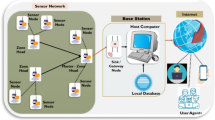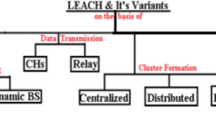Abstract
Hierarchical routing and clustering mechanisms in Wireless Sensor Networks (WSN) help to reduce the energy consumptions and the overhead created when all the sensor nodes in the network are sending information to the central data collection point. Most of the routing and clustering protocols proposed for WSN assume that the nodes are stationary. However, in applications like habitat monitoring or search and rescue, that assumption makes those clustering mechanisms invalid, since the static nature of sensors is not real. In this paper, we propose Zone-based Routing Protocol for Mobile Sensor Networks (ZoroMSN) that considers the design aspects such as mobility of sensors, zones and routes maintenance, information update and communication between sensor nodes. Simulation results show the effectiveness and strengths of the ZoroMSN protocol such as a low routing and mobility overhead, while achieving a good performance in WSN using small zone sizes and sensors with low speed. Simulation results also show that ZoroMSN outperforms existing LEACH-ME and LEACH-M protocols in terms of network lifetime and energy consumptions.
Similar content being viewed by others
Explore related subjects
Discover the latest articles, news and stories from top researchers in related subjects.References
Akyildiz, I. F., Su, W., Sankarasubramanian, Y., & Cayirci, E. (2001). Wireless sensor networks: a survey (Georgia Tech Technical Report). December.
Al-Karaki, J. N., & Kamal, A. E. (2004). Routing techniques in wireless sensor networks: a survey. Department of Electrical and Computer Engineering, Iowa State University, December.
Arboleda, L. M., & Nasser, N. (2006). Comparison of clustering algorithms and protocols for wireless sensor networks. In IEEE Canadian conference on electrical and computer engineering (CCECE), Ottawa, May 2006.
Aurenhammer, F. (1991). Voronoi diagrams—a survey of a fundamental geometric data structure. ACM Computing Surveys, 23, 345–405.
Barbeau, M., Kranakis, E., Krizanc, D., & Morin, P. (2004). Improving distance based geographic location techniques in sensor networks. In 3rd international conference on ADHOC networks and wireless, Vancouver, British Columbia, July 2004.
Benenson, Z., Gärtner, F., & Kesdogan, D. (2004). User authentication in sensor networks (extended abstract), Germany.
Butler, Z., Corke, P., Peterson, R., & Rus, D. (2004). Networked cows: virtual fences for controlling cows. In WAMES 2004, Boston, USA, June 2004.
Chan, H., & Perrig, A. (2004). ACE: an emergent algorithm for highly uniform cluster formation. In Proceedings of the first European workshop on sensor networks (EWSN), January 2004.
Martirosyan, A., Boukerche, A., & Pazzi, R. W. N. (2008). A taxonomy of cluster-based routing protocols for wireless sensor networks. In Parallel architectures, algorithms, and networks, I-SPAN 2008. International symposium on (pp. 247–253).
Kim, D.-S., & Chung, Y.-J. (2006). Self-organization routing protocol supporting mobile nodes for wireless sensor network. In Proceedings of the first international multi-symposiums on computer and computational sciences (IMSCCS’06).
Fang, Q., Zhao, F., & Guibas, L. (2003). Lightweight sensing and communication protocols for target enumeration and aggregation. In Proceedings of the 4 th ACM international symposium on mobile ad hoc networking and computing (MOBIHOC) (pp. 165–176).
Heinzelman, W. B. (2000). Application specific protocol architectures for wireless networks. PhD thesis, Massachusetts Institute of Technology, June.
Heinzelman, W., Chandrakasan, A., & Balakrishnan, H. (2000). Energy-efficient communication protocol for wireless microsensor networks. In Proceedings of the 33rd Hawaii international conference on system sciences, January 2000.
Ibriq, J., & Mahgoub, I. (2004). Cluster-based routing in wireless sensor networks: issues and challenges. In Proceedings of the 2004 symposium on performance evaluation of computer telecommunication systems.
Intanagonwiwat, C., Govindan, R., & Estrin, D. (2000). Directed diffusion: a scalable and robust communication paradigm for sensor networks. In Proceedings of the sixth annual international conference on mobile computing and networking (MobiCOM ’00), Boston, Massachussetts, August 2000.
Juang, P., Oki, H., Wang, O., Martonosi, M., Peh, L.-S., & Rubestein, D. (2002). Energy-efficient computing for wildlife tracking: design tradeoffs and early experiences with Zebranet. In ASPLOS, San Jose, CA, Oct. 2002.
Kamimura, J., Wakamiya, N., & Murata, M. (2004). Energy-efficient clustering method for data gathering in sensor networks. In First annual international conference on broadband networks, BROADNETS, San Jose, CA, Oct.
Kumar, G. S., Vinu Paul, M. V., Athithan, G., & Jacob, K. P. (2008). Routing protocol enhancement for handling node mobility in wireless sensor networks. In TENCON 2008—2008 IEEE Region 10 conf. (pp. 1–6).
Lindsey, S., & Raghavendra, C. S. (2002). PEGASIS power-efficient gathering in sensor information systems. In IEEE aerospace conference.
Liu, C., Wu, K., & Pei, J. (2005). A dynamic clustering and scheduling approach to energy saving in data collection from wireless sensor networks. In Second annual IEEE communications society conference on sensor and ad hoc communications and networks (SECON 05), Santa Clara, California, September 2005.
Luo, J., & Hubaux, J.-P. (2005). Joint mobility and routing for lifetime elongation in wireless sensor networks. In IEEE INFOCOM 2005, Miami, March.
Mainwaring, A., Polastre, J., Szewczyk, R., Culler, D., & Anderson, J. (2002). Wireless sensor networks for habitat monitoring. In ACM international workshop on wireless sensor networks and applications (WSNA’02), Atlanta, GA, Sept. 2002.
Manjeshwar, A., & Agrawal, D. P. (2001). TEEN: a routing protocol for enhanced efficiency in wireless sensor networks. In Proceedings of the 15th international and distributed processing symposium.
Manjeshwar, A., & Agrawal, D. P. (2002). APTEEN: a hybrid protocol for efficient routing and comprehensive information retrieval in wireless sensor networks. In Proceedings of the international and distributed processing symposium.
Moses, R., Krishnamurthy, D., & Patterson, R. (2002). A self-localization method for wireless sensor networks. EURASIP Journal on Applied Signal Processing.
Nguyen, X., Jordan, M. I., & Sinopoli, B. (2005). A kernel-based learning approach to ad hoc sensor network localization. ACM Transactions on Sensor Networks, 1(1), 134–152.
Niculescu, D., & Nathi, B. (2003). Ad hoc positioning system (APS). In INFOCOM 2003, San Francisco, CA.
Ni, S. Y., Tseng, Y. C., Chen, Y. S., & Sheu, J. P. (1999). The broadcast storm problem in a mobile ad hoc network. In Proceedings of the fifth annual ACM/IEEE international conference on mobile computing and networking (MobiCom’99).
Raghavendra, C. S., Sivalingham, K. M., & Znatti, T. F. (2004). Wireless sensor networks. Dordrecht: Kluwer Academic.
Samal, S. (2003). Mobility pattern aware routing in mobile ad hoc networks. MSc. dissertation, Virginia Polytechnic Institute and State University, May.
Savvides, A., Han, C. C., & Strivastava, M. B. (2001). Dynamic fine-grained localization in ad-hoc networks of sensors. In Proceedings of the seventh annual ACM/IEEE international conference on mobile computing and networking (MobiCom 2001), Rome, Italy, July 2001.
Schurgers, C., & Srivastava, M. (2001). Energy efficient routing in wireless sensor networks. In MILCOM.
Soro, S., & Heinzelman, W. B. (2005). Prolonging the lifetime of wireless sensor networks via unequal clustering. In Proceedings of the 5th international workshop on algorithms for wireless, mobile, ad hoc and sensor networks (IEEE WMAN’05).
Tilak, S., Abu-Ghazaleh, N. B., & Heinzelman, W. (2002). Infrastructure tradeoffs for sensor networks. In Proceedings of the ACM international workshop on wireless sensor networks and applications.
TurtleNet University of Massachusetts Amhersts. http://prisms.cs.umass.edu/dome/index.php?page=turtlenet.
Vyas, N., & Mahgoub, I. (2003). Location and mobility pattern based routing algorithm for mobile ad hoc wireless networks. In 2003 international symposium on performance evaluation of computer and telecommunication systems.
Virrankoski, R., & Savvides, A. (2005). TASC: topology adaptive clustering for sensor networks. In Proceedings of the second IEEE international conference on mobile ad-hoc and sensor systems, MASS 2005, ENALAB Technical Report 110401, Washington DC, November 2005.
Wang, K., Abu-Ayyash, S., Little, T. D. C., & Basu, P. (2005). Attribute-based clustering for information dissemination in wireless sensor networks. In Proc. 2nd annual IEEE communications society conf. on sensor and ad hoc communications and networks (SECON 2005), Santa Clara, CA, September 2005.
Ye, M., Li, C., Chen, G., & Wu, J. (2005) EECS: an energy efficient clustering scheme in wireless sensor networks. National Laboratory of Novel Software Technology, Nanjing University, China, Department of Computer Science and Engineering, Florida Atlantic University, USA.
Yoon, S., & Shahabi, C. Exploiting spatial correlation towards an energy efficient clustered aggregation technique (CAG). In: IEEE international conference on communications.
Yoon, S., & Shahabi, C. An experimental study of the effectiveness of clustered aggregation (CAG) leveraging spatial and temporal correlations in wireless sensor networks. ACM Transactions on Sensor Networks (Technical Report 05-869). USC (University of Southern California) Computer Science Department.
Younis, O., & Fahmy, S. (2004). HEED: a hybrid, energy-efficient, distributed clustering approach for ad hoc sensor networks. IEEE Transactions on Mobile Computing.
Author information
Authors and Affiliations
Corresponding author
Rights and permissions
About this article
Cite this article
Nasser, N., Al-Yatama, A. & Saleh, K. Zone-based routing protocol with mobility consideration for wireless sensor networks. Telecommun Syst 52, 2541–2560 (2013). https://doi.org/10.1007/s11235-011-9562-9
Published:
Issue Date:
DOI: https://doi.org/10.1007/s11235-011-9562-9




